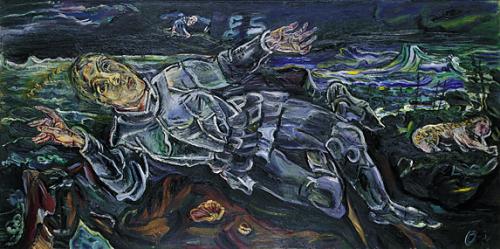The Artist Observed
dal 14/1/2004 al 2/5/2004
Segnalato da
Anthony Van Dyck
Rembrandt van Rijn
James McNeill Whistler
Auguste Rodin
Oskar Kokoschka
Ansel Adams
Georgia O'Keeffe
Willem de Kooning
Bill Brandt
Georges Braque
August Sander
Henri Matisse
Marcel Duchamp
Alex Katz
Betsy G. Fryberger
14/1/2004
The Artist Observed
Cantor Arts Center, Stanford
Portraits and Self-Portraits: images of artists from the early 17th century to the present. The exhibition includes more than 60 prints, drawings, and photographs ranging from formal group portraits to quick, intimate sketches and caricatures of artists. Included are works by such influential artists as Anthony Van Dyck, Rembrandt van Rijn, Giovanni Benedetto Castiglione, James McNeill Whistler, Auguste Rodin, Oskar Kokoschka and Ansel Adams, Henri Matisse, Marcel Duchamp, Alex Katz. Photographic portraiture takes center stage with a group that includes Georgia O'Keeffe, Harry Bowden of his friend Willem de Kooning's New York studio and Bill Brandt of Georges Braque.

The Cantor Arts Center at Stanford University presents images of artists from the early 17th century to the present in The Artist Observed: Portraits and Self-Portraits, January 14–May 2. The exhibition includes more than 60 prints, drawings, and photographs ranging from formal group portraits to quick, intimate sketches and caricatures of artists.
Included are works by such influential artists as Anthony Van Dyck, Rembrandt van Rijn, Giovanni Benedetto Castiglione, James McNeill Whistler, Auguste Rodin, Oskar Kokoschka, and Ansel Adams. Their observations create a lively narrative across four centuries, reflected in the artists' features, poses, and situations. The exhibition also documents the evolving character of portraiture. Betsy G. Fryberger, the Cantor Arts Center curator of prints and drawings who is responsible for this exhibition, also selected prints depicting studios of painters, sculptors, and printmakers.
The 20th-century section begins with self-portraits by Lovis Corinth, Oskar Kokoschka, and August Sander as well as Edward Steichen's photograph of Henri Matisse working on a sculpture and Jacques Villon's sketch of his brother Marcel Duchamp playing cards. A self-portrait lithograph by Alex Katz, printed some 50 years later, shows him hidden behind sunglasses.
Photographic portraiture takes center stage with a group that includes Ansel Adams of Georgia O'Keeffe, Harry Bowden of his friend Willem de Kooning's New York studio, and Bill Brandt of Georges Braque. Also included are photographs taken at Stanford by Leo Holub of Richard Diebenkorn, Frank Lobdell, and others.
The exhibition is made possible by a grant from the Dr. A. Jess Shenson and Dr. Ben Shenson Funds, the Halperin Exhibitions Fund, and the School of Humanities and Sciences.
Two additional exhibition spaces at the Center present works that augment The Artist Observed. From October 18, 2003 through February 2004, a small grouping of works by Victorian photographer Julia Margaret Cameron are on view in an adjacent gallery. Cameron took up the new medium late in life and was reviled by some for her ''willfully imperfect'' portraits, but praised by others for her work's unusual emotional intensity. She created memorable portraits of her friends and family, who included the Poet Laureate Alfred, Lord Tennyson; Charles Darwin; Cameron's niece Julia Jackson (who became the mother of Virginia Woolf); and the botanist Marianne North; as well as allegorical subjects.
The Cantor Arts Center's intimate Patricia S. Rebele Gallery, known as ''the museum living room,'' presents individual works for leisurely and comfortable viewing. Two 1856 bronze busts by French sculptor Charles-Henri-Joseph Cordier (1827–1905), on view from December 12, 2003 through February 2004 pose the question, ''When Is a 'Portrait' Not a Portrait?'' Reflecting an intense European curiosity about the peoples of foreign lands, Cordier was deeply engaged in studying foreign people and is today best known for his extraordinary ethnographic ''portraits.'' These two busts represent not individuals, but rather characteristic, or exemplary types. The color lithograph by Red Grooms Masters at the Met, 2002, replaces the busts in the gallery in March.
Image: Knight Errant (Der Irrende ritter), 1915. Oil on canvas, 35 1/4 x 70 7/8 inches. Solomon R. Guggenheim Museum
Iris & B. Gerald Cantor Center for Visual Arts, Stanford University Stanford
328 Lomita Drive and Museum Way (off Palm Drive) Stanford, CA 94305-5060



